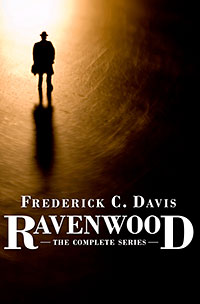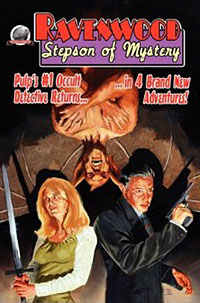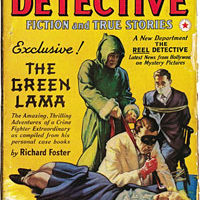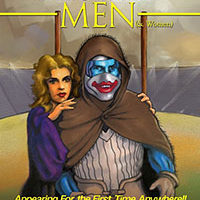 Ravenwood was a short-lived pulp hero series that ran in the back of Secret Agent X for five issues in 1936.
Ravenwood was a short-lived pulp hero series that ran in the back of Secret Agent X for five issues in 1936.
Like all the pulp characters from Ace (aka Magazine Publishers or Periodical House), Ravenwood is now in the public domain. Written by long-time pulp scribe Frederick C. Davis (Moon Man, Operator #5, and others), Ravenwood was an occult detective.
What set him apart was that he actually had occult powers. In the pulps, most “occult powers” are either fake or in use only by the villains (examples: Dr. Satan, Dr. Death, etc). Some have apparently wondered if this character was an inspiration for Marvel Comics’ Dr. Strange due to some similarities.
Ravenwood was orphaned in Tibet when his rich, missionary doctor parents are killed. Rescued by the Nameless One, a Tibetan mystic, he is instructed in the ways of the occult. Returning to New York as a rich playboy (shades of several comic book and pulp heroes), he works as an occult detective, dealing with cases that seem to have a bizarre explanation (cursed Buddha, Handshake of Death, etc). Ravenwood’s edge is his occult powers, which is to basically seeing information that is hidden, or knowing that something will happen before it does. As the information he gets is sometimes unclear, he has to figure it out. Sometimes the Nameless One is a source of information or warns him telepathically.
Reoccurring characters are few in these stories. There is Ravenwood (no first name), his valet Sterling (again, no first name), the Nameless One who lives with Ravenwood in his apartment and never leaves, and Stagg, a police inspector who usually thinks Ravenwood is involved in the case due to his advanced knowledge. Missing is any kind of love interest or other recurring assistant character.
The stories all seem to have a supernatural cause, but are usually dealing with revenge and subterfuge. Not much action, and sometimes it seems that Ravenwood is just running around gathering clues. So a lot of room for improvement.
Altus Press published a complete reprint of the series. The only negatives for this collection is that I found the cover dull and the info on the cover and write-up did not lead me to get this book. I was a little disappointed that only one piece of interior artwork was included (were there no others?). On the back cover we get the covers of the five issues of Secret Agent X, but in sepia tone. I understand Altus is thinking of revamping this book, so hopefully that will help.
Airship 27 has put out two collection of new Ravenwood stories. Each collection presents four new stories of Ravenwood, written by four New Pulp authors. This means, they have published more Ravenwood stories than in the original pulps!
For me, the biggest issue with such works are whether the stories stay true to the original characters. I don’t feel that authors need to ape the original style, but they shouldn’t be making radical changes in the character. I don’t mind if they make additions, so long as those additions seem to be something that could have happened with that character. I did like how the information on one author mentioned she delved into the character to get him right.
 In the first collection, “Ravenwood, Stepson of Mystery,” first up is a story by Frank Schildiner, who pits Ravenwood against Sun Koh and Lovecraftian horrors. Sun Koh is actually a German pulp character from pre-WWII who is described as a sort-of German/Nazi Doc Savage. He’s actually a prince of Atlantis sent forward in time. Art Sippo has been writing a great new series of this character, but Frank chose to make Sun Koh insane and totally evil, which I think doesn’t quite work for the character. He has also reduced Jan Mayer, another German pulp character more like a modern Robur, into just a generic SS officer.
In the first collection, “Ravenwood, Stepson of Mystery,” first up is a story by Frank Schildiner, who pits Ravenwood against Sun Koh and Lovecraftian horrors. Sun Koh is actually a German pulp character from pre-WWII who is described as a sort-of German/Nazi Doc Savage. He’s actually a prince of Atlantis sent forward in time. Art Sippo has been writing a great new series of this character, but Frank chose to make Sun Koh insane and totally evil, which I think doesn’t quite work for the character. He has also reduced Jan Mayer, another German pulp character more like a modern Robur, into just a generic SS officer.
Also, he makes some changes to Ravenwood, giving him the ability to cast spells, and has the Nameless One appear as a spectral figure giving advice. These changes I don’t think are inline with the original.
Next up is a story by B.C. Bell, having Ravenwood deal with Yetimen. Bell admits to having read the original stories, and this shows through in this story. He keeps the story and its characters true to the original, though he doesn’t bother aping the original style (which is fine). He actually adds a supernatural element to the story, which is missing from the original. I accept this change, as I think it’s due to where the original stories was published, as other pulp magazines would have accepted the supernatural.
Zombies are the focus of the next story by Bill Gladman. It doesn’t appear that Bill has read the original stories, and it shows by many incorrect aspects. He has Ravenwood having telepathic conversations with the Nameless One, who feeds Ravenwood information, rather than having Ravenwood be able to obtain information with his own powers. And instead of the Nameless One giving information in allusions, it’s clear info.
Other details are messed up, like placing Ravenwood’s penthouse on the 13th floor instead of the 30th, and adding a second floor to it and a mediation room rather than him spending time in his library/office. Certainly the storyline would have worked with the originals, but these alterations are annoying.
Finally we have Bobby Nash with a story focusing on ghosts and jazz. Annoyingly, here, too, the character of Ravenwood is off from what it should be. Overall the way the story was laid out and how many characters are dealt with are not in line with the original. These changes are so radical that it’s the one story I really didn’t care for.
In the second volume (“Ravenwood, Stepson of Mystery, Vol. 2”), we first off have a story by Janet Harriett that involves Ravenwood in the theft of a mechanical man (based on Elektro from the 1939 World’s Fair). During the case, Ravenwood uncovers a secret of someone involved in the theft.
Aaron Smith‘s story teams Ravenwood with The Black Bat as they deal with ritualistic murders and other horrors, as a group of people try to summon the Old Ones to our world. The Black Bat was handled well, but was a little concerned about the use of Ravenwood and the Nameless One. A level of psychic power was given to both that they didn’t have in the original. Kind of necessary for the story, since it pits them against Lovecraftian horror. I hope this leads to further stories of Ravenwood teaming up with other pulp heroes.
In the next story, Jonathan Fisher involves Ravenwood in alchemy. A crazy alchemist creates a toxin he wishes to inflict on New York. Working with others, Ravenwood tries to stop him. Will he succeed? The other characters who work with Ravenwood are very interesting. This is almost an ensemble story then a Ravenwood story. They are interesting enough that it would be nice to see them in a future story, tho there would have to be a need for them.
The final story, by Gene Moyers, also pits Ravenwood against occult horrors. Again, Ravenwood is pulled into a case that is much larger and more sinister then it first appears.
If you like occult detectives, you should check out this lesser-known pulp hero. Get the Altus Press collection for the originals, then move on the Airship 27 for new stories. All are great. I look forward to the next collection of new stories.



